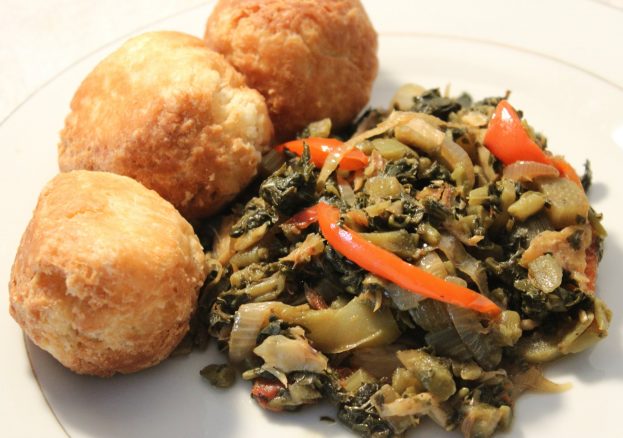
The actual origins of Callaloo are widely contested. For Trinidadians, Callaloo is one part of their national dish: Crab and Callaloo- a dish which was created by the African slaves sometime around 1530 when the island was under Spanish occupation.
It means that whilst the dish may be a national staple on both islands in Trinidad and Tobago, the origins of the dish stem long after the arrival of African slaves circa-1510. Furthermore, documents detailing the cuisine of Africans by English and Dutch Explorers in the 1400’s, depict Callaloo as a regular ingredient in dishes, most noticeably ones which include spinach.
However, the difference in preparation between African Callaloo and that found in the Caribbean and particularly in Trinidad and Tobago is the use of Palm oil. As a readily available plant throughout West Africa, Palm Oil was and still is used in a variety of dishes throughout Nigeria, Congo, Sierra Leone and Angola. However, in the Caribbean, where Palm trees and alas, Palm Oil is not native or wildly available, the slaves in the 1530’s were forced to improvise using what was readily available near or on their plantations- Coconut palm.
As the processes between Coconut oil and Palm Oil are vastly different, the resulting oil not only changes the depth of flavours between the two different types of Callaloo, but their flavour profiles and health properties as well, with Palm Oil having more carcinogenic properties than its coconut oil variant, as well as having a more ‘slimy’ texture and slightly more bitter taste.
Regardless of the flavour of food, the Slaves merely sought out the oil for its ability to keep the Callaloos’ texture firm and consistent throughout the dish, preventing it from becoming almost paste like in consistency.
Yet surprisingly, the method of how the slaves extracted the oil from the Coconut palm is relatively unchanged over the past 400 years, with the slaves initially grating a dry coconut into a pulp before squeezing the liquid out through a sieve, resulting in a product that had the colour of milk which they would then add into the ingredients to make Callaloo.
Now whilst Callaloo was a tasty and often filling morsel for the ill-treated slaves to dine on, the time consuming nature of creating Callaloo from scratch was often too risky for it to be a regular form of sustenance. As such, an alternative was forcibly needed; dumplings.
Whilst both Caribbean and African cuisines now use a combination of plain and self-raising flour made from wheat for their dumplings today, the Slaves would not have had access to wheat crops. Instead, Cassava, which was cultivated by several plantations for its similarities to wheat and potatoes, would make the first adaptations of dumplings in the West Indies.
In both cases, where the ingenuity of the enslaved lay was what they accompanied their carbohydrate heavy dishes with; seafood. As crabs were often the most easy to catch of all the seafood available due to Trinidad and Tobago’s abundance of shorelines, Crabs rock pooling along the shore were easy targets for slaves looking for a quick bite.
As restrictions on the movement of slave both on and off the plantation grew and the penalties for escaping or even wondering out of the plantation became more severe, the use of crabs fizzled out by the mid 1500’s. Instead, the enslaved were forced to look for an alternative to their dish- which they found in saltfish.
Initially used as a fertiliser for the crops, ‘Salt-fish’- which was merely any white fish that was doused in salt, was often useable fish that slave owners did not want to use to feed their slaves/. Initially, the fertiliser was fresh fish, but after slaves ate the fish whilst working the fields, Plantation owners added salt to deter their slaves from eating the produce. As such, initial adopters of raw Saltfish were those who were hungry; a decision which often became a cause for their death due to dehydration. Those who were caught eating the salt fish were reprimanded with lashes, muzzles and in the case of known repeat offenders, the removal of their tongue.
It meant that for the Saltfish to become a useable or even integral part of a meal, it had to be processed- which was often done by ‘washing’ the salt off the fish where available, boiling the fish till the salt came off as a silted layer in the water, or soaking the fish till the taste of the salt was almost completely removed.
Today, Callaloo with Dumplings and Saltfish is a hearty, filling meal eaten by Trinidadians, often on a Sunday when available. In recent years, and with the growing acknowledgement of Trinidad’s Asian influence, Roti is included or even used to substitute for the Dumplings, whilst Crabs have been re-introduced into the dish to accompany and even contrast the more savoury flavour of the Salted fish.
